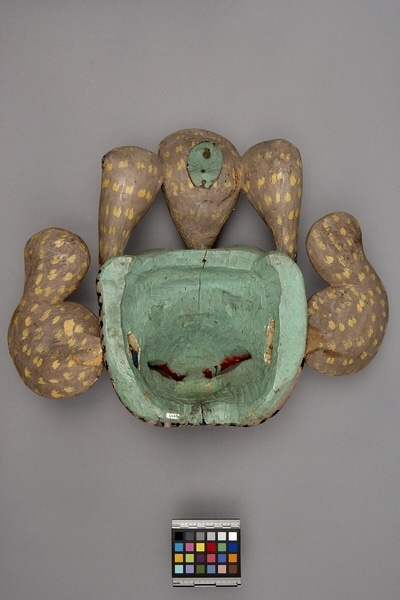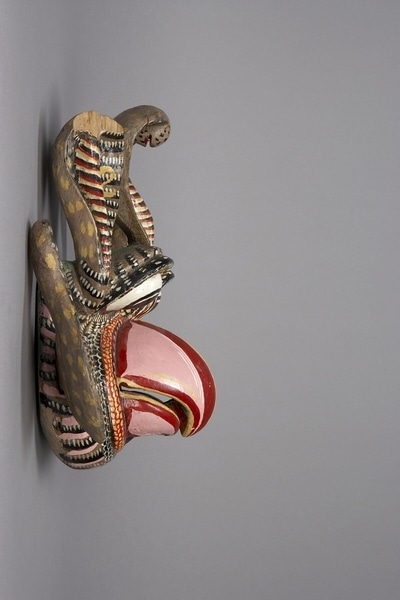Mask Item Number: Eh47 a-c from the MOA: University of British Columbia




Description
Mask depicting a bird figure: the central head segment (a) has a pink and red beak, large bulging eyes, eyebrows with a petal motif in red, yellow, green, white and black, a scaled pattern in red, yellow, white, pink, grey and black on the face, and a headdress composed of three cobras with their hoods extended; the earpieces (b and c) are two cobras, each with their heads extended upwards and their tails wrapped around a dish-shaped disc that has a flower design.
History Of Use
The Kolam is a secular entertainment with considerable elements of social satire. It incorporates narrative, mime, dance, and music. A Kolam performance usually has four episodes the precise content of which may vary. These consist of a prelude, detailing the origin of the drama; the arrival of a royal party and dances by characters mythical, human and animal; enactment of a popular story or stories; and a purifying demon dance. This mask represents Na Gurulu or Bhuma-Naraja (Garuda of snakes) which depicts a great mythical bird which devours snakes.
Iconographic Meaning
This character is usually depicted as a bird wrapped in coils of fighting cobras with spread hoods and is usually painted red, symbolizing serpent blood. Na, short for naga is a semi-divine being in the form of a cobra. A naga is very powerful and dangerous. It symbolizes the life force that motivates birth and rebirth; the conquest of the blind will for life; fertility and opulence and wealth.
Cultural Context
exorcism
Item History
- Made in Sri Lanka before 1978
- Collected during 1978
- Owned by Jason Schoonover before February 10, 1981
- Received from Museum of Anthropology Shop Volunteers (Funding source) and Jason Schoonover (Seller) on February 10, 1981
What
- Name
- Mask
- Identification Number
- Eh47 a-c
- Type of Item
- mask
- Material
- paint and nux vomica wood ?
- Manufacturing Technique
- carved and painted
- Overall
- height 36.5 cm, width 45.0 cm, depth 17.5 cm
Who
- Culture
- Sinhalese
- Previous Owner
- Jason Schoonover
- Received from
- Museum of Anthropology Shop Volunteers (Funding source) and Jason Schoonover (Seller)
Where
- Holding Institution
- MOA: University of British Columbia
- Made in
- Sri Lanka
When
- Creation Date
- before 1978
- Collection Date
- during 1978
- Ownership Date
- before February 10, 1981
- Acquisition Date
- on February 10, 1981
Other
- Condition
- fair
- Accession Number
- 0704/0046 a-c